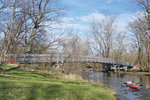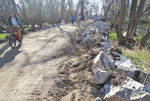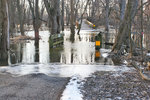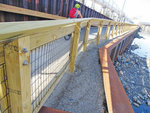




On Easter Sunday 2019, the first warm day of spring, throngs of rumpled, pale people ventured outside to behold a secular resurrection.
Four and a half years after Ingham County voters approved a six-year trails and parks millage, miles of smooth, fresh trail sausage are finally extruding from the machinery.
Sunday strollers, bikers and joggers discovered that long swaths of the aging Lansing River Trail were repaved last fall, including the oldest part of the trail downtown.
More sections, especially in the forested area between the Potter Park Zoo and Kalamazoo Street, will be repaved later this month, when asphalt plants resume operation after shutting down for the winter.
A graceful new $1.8 million bridge over a flood-prone section of the Red Cedar River, longer and higher than the old one, is making its debut. The east approach to the bridge, cracked and crumbling for years, has been beefed up with landfill and boulders. Eroded banks have been shored up with Lake Michigan-worthy seawall near Moores River Park. Four bridges on East Lansing’s Northern Tier Trail have been replaced, the trail has been repaved and more fixes are on the way this year.
There’s a lot more trail in the works, but there are rocks in the path. Many trail lovers, including the Ingham County Commissioners themselves, are not satisfied with the ponderous machinery set in motion by the millage and would like to see the sausage come out faster.
Mussels and money
The Appian Way from Capua to Rome, about twice the width of the Lansing River Trail and 132 miles long, was built in a year — 312 B.C.
How did they do it? Appius Claudius didn’t have to go through the Ingham County trail millage’s grant application process.
Melissa Buzzard, the county’s parks and trails millage coordinator, said 20 extensions were granted to county trail projects in the past two years.
Among the causes for delay were an asphalt workers’ strike last year and the discovery of endangered mussels in the Grand and Red Cedar rivers, requiring additional studies and workarounds. “You can’t foresee an asphalt strike or a problem with endangered species,” Buzzard said.
But Ingham County commissioners are more interested in streamlining the process by which projects are approved and built.
“Voters passed the trail millage back in 2014 and really haven’t seen a ton happen since,” County Commissioner Thomas Morgan said.
In February, the commissioners passed a resolution fast-tracking the 2019 round of trail projects and doubling the amount of money given to municipalities up front to pay for them, from 25% to 50% of the cost of the project. (The rest is reimbursed when the project is finished.)
Morgan dubbed the February resolution “Fix the Damn Trails,” a tip of the hat to Gov. Gretchen Whitmer’s campaign slogan.
“We felt it was time to give residents something to show for their money,” Morgan said. “I couldn’t support putting it back on the ballot again if we’re not using the funding people so graciously provided.” The millage is up for renewal in 2020.
Ingham Parks Commissioner Matthew Bennett is confident that this spring, people will notice that things are moving.
“We have a lot of trails that are slated to be finished this year,” Bennett said. “It’s going to be a lot more apparent the county that the trails are getting done.”
Trail grant applications are evaluated in two steps. First, the county parks board works with a consultant, the Spicer Group, to vet the grant proposals. The parks board ranks the projects on a point system. Trail projects that enhance connectivity between communities, a signature goal of the trails millage, score higher. The parks board submits the rankings to the board of commissioners for approval.
Bennett is the only parks commissioner who has taken part in the process since before the millage was passed in 2014.
“We’ve tweaked the scoring a few times and streamlined the process,” he said.
But Morgan called the process “problematic.”
“Imagine if the Capital Area District Libraries had a competitive grant process every year, and all the individual libraries had to show they deserved money to buy books,” he said. “It’s ridiculous, but we’re doing the exact same thing with this trail funding instead of working together as a county and finding a cohesive plan.”
Bennett said the competitive model isn’t perfect, but it has the benefit of putting individual communities in the driver’s seat.
“They tell us what they feel is important,” Bennett said. “The alternative would be to directly fund things. We’d say, ‘OK, Meridian Township, we think you should have a trail from here to here and here’s the money.’ But you’re still picking and choosing.”
The county has made it a priority to leverage as much of the trails millage as possible by encouraging municipalities to get matching funds from the federal Transportation Alternatives Program, or TAP, program, administered by the states.
It can take up to a year for the Michigan Department of Transportation to process a TAP grant application while county trail millage money allocated to the project sits around. “You have to verify that the county money is available to even apply for TAP,” Bennett said.
Morgan said matching funds are “great,” but a project shouldn’t be held up for a year or more to wait for them, as happened with Delhi Township’s application for a grant to build more trails last year.
“A regular person looking to enjoy a trail — their fate should not be decided on their township’s ability to write a grant,” Morgan said.
From fixes to frontiers
Behind the visible results users are seeing this spring, there is a lot of sausage moving through the works. After the county commission’s February round of grant approvals, all of the county’s trails millage money is has been allocated to future projects, Bennett said.
“It looks like we haven’t given out money, but we have,” Bennett said. “Maybe we haven’t done as good a job as we should explaining it.”
Buzzard put it this way: “The dollars projected to come in through the end of the millage, based on about $3.5 million a year, have met their cap.”
A quick survey of the four rounds of grants awarded by the county so far, from 2016 to 2019, show a slow but steady pivot from repairs to new trails.
The first round of grants, awarded in 2016, was almost entirely taken up by repaving, bridge replacements, erosion control work and other much-needed fixes in Lansing, Meridian Township, East Lansing and Mason. All of those fixes are either done or will be done by the end of spring.
To get a sense of how far gone the Lansing River Trail was, users can still check out the alligator-ish eastern section near the Crego Park spur, set to be resurfaced in May, where the pavement is riven with deep cracks and loose fragments.
The second round, awarded in 2017, was still heavy on repairs, but included an extension to Mason’s Hayhoe Riverwalk Trail, finished last fall, and planning and design work on a few new projects, including Phase 1 of a much-requested MSU to Lake Lansing path.
The 2018 round included more repairs and bridge replacements in Lansing, but also funded an extension to the Fenner Nature Center, set to be finished this year. The 2018 round also included resurfacing of the Lakelands Trail in southern Ingham County, which will hook up to the epic “Route 1” trail traversing Michigan from Port Huron to Grand Haven.
The 2019 round, approved in February, includes two new connectors to the trail system in East Lansing, more bridge replacements in Lansing (including the aging Pennsylvania Avenue overpass and nearby boardwalk) and the first phase of a long-awaited new trail from Holt to Mason.
The 2019 round also includes the first “water trail” funded by the millage. It’s a modest grant of $50,000, but the money will go toward clearing numerous logjams and other obstructions that discourage kayakers from using tight stretches of the Red Cedar and Grand rivers.
By now, so many projects have been approved, Bennett said, the millage is “over-allocated.”
“The possibility was raised that we could look up and see a negative balance, but that hasn’t happened yet,” Morgan said. “And if that were to happen, we would just have to delay a project. The point is to get some shovels in the ground and get these projects moving forward.”
MSU to Lake Lansing
The shovels often have to wait quite a while to get dirty, especially when building new trails. Meridian Township engineer Younes Ishraidi is in the thick of intense planning for one of the most requested trails in the county, a five-mile spur from MSU to Lake Lansing.
At the mention of a ribbon cutting, he smiled.
“From your mouth to God’s ears,” he said. “This thing is something else.”
Ishraidi and his team are taking soil samples and doing other preliminary work, with plans to put shovels in the ground in fall 2020, but it’s taken years just to get the project this far.
The project has been chopped into three phases. Phase 1 will stretch from MSU to Park Lake Road and Grand River Avenue, mostly along the north bank of the Red Cedar River.
“Not a lot of communities can fund this big a project,” Ishraidi said. To strengthen the bid for county millage funds, Meridian Township applied for federal matching funds first. “We knew the TAP would take a long time, so we started working with MDOT in 2016,” Ishraidi said.
But the state demanded a feasibility study, not just for Phase 1, but for the entire project. That took almost a year to complete. Phase 1 finally received a “conditional commitment” from MDOT for $1.7 million in TAP funding late in 2018. The project will also use $950,000 from the county trails millage and $350,000 of township money.
“Now we’re on a ticking clock to get it done,” Ishraidi said. The design has to be finalized; easements from private landowners along the route have to be secured, and river crossings will require permits from the state’s Department of Environmental Quality.
Any project that uses TAP money has to abide by federal standards. Paved trail must be a minimum of 10 feet wide (about half the width of the Appian Way). Bridges and boardwalks have to be 14 feet wide.
Phase 2 will pick up the trail at Park Lake Road, continue along an existing pathway along Grand River Avenue and cut across a patch of preserved township land to Okemos Road. Ingham County green-lighted Phase 2, to the tune of $645,000 of county millage money, earlier this year.
Phase 3 will take the trail the rest of the way to Lake Lansing.
Fortunately, most of the affected property along Phase 1 consists of student apartment blocks. Far from resisting the trail, most owners are eager to claim the trail as an amenity, Israidi said.
“Besides, the general attitude of the public about trails is changing,” Ishraidi said. “People see the benefits, how accessible they can be, and society’s becoming more healthy.”
Endgame: Great Lakes
Last fall, when steam shovels pulled up old sections of the Lansing River Trail for replacement, the man who laid some of the original trails down in the 1980s rejoiced.
George Hayhoe grew up in Mason, where his family owned Capitol Excavating and Paving. He’s been involved in trails from every angle possible, 25 years ago as a paver and contractor, then as a civil engineer at MSU, then an attorney who graduated from Cooley Law School.
He’s now an avid user and a financial benefactor of the trail system, especially in Mason. He’s a board member of the Friends of the Lansing Regional Trails and the Michigan Trails and Greenways Alliance, a statewide advocacy network.
To locals in Mason, he’s the Trail Man.
Recently, he has concentrated on a long-held dream of linking Mason to the southernmost spur of the Lansing River Trail system, the two-year-old Sycamore Trail that ends in Holt.
It’s happening. Last fall, Mason extended its existing trail along Howell Road to Kerns Road, so the trail now stretches 3 miles through Mason. Later this year, it will be extended along Kerns to Cedar Street as part of a Kerns Street reconstruction.
Connecting as many regional attractions and parks to each other is the prime directive of the county millage.
“Studies show again and again that the more connected the trails are, the more use they get,” Hayhoe said. “Connecting communities is a key theme in everything we’re trying to do.”
Ground has broken on a park near Mason, Esker Landing, which will open nearby Cedar Lake to the public, with a nonmotorized boat launch and trailhead parking lot.
“When it’s completed later this year, Lansing’s River Trail system will connect all the way to the park,” Hayhoe said.
From there, the next leg of the Holt-to-Mason trail will run about 2 miles to the south Delhi Township line at College Road, largely using trail millage funds, leaving another mile and a half to connect it all together.
“When we first started building trails in Mason in 2000, that’s been our goal all along, to connect Mason to Delhi Township and to the greater Lansing network,” Hayhoe said.
Hayhoe and his wife, Lisa, are a frequent sight on local trails and around the state. He spent some quality time last week on East Lansing’s North Tier Trail, near the Aquatics Center, listening to a chorus of wood frogs.
He is elated to be alive in a golden age of trail building.
Part of the newly added section of the Mason trail near Howell Road traverses Sycamore Creek and a tricky patch of wetland. Instead of driving straight piles, engineers mounted the boardwalk on giant metal screws 40-to-50 feet deep, corkscrewed into the ground.
“It was a very creative way to do it without digging, almost no impact on the surrounding environment,” he said. “We are so impressed with the creativity of the engineers in getting people from one point to another.”
In future phases, the focus for Ingham County trails will be on connecting the Lansing network to the big cross-state trails, “so people can do ecotourism and go pretty much wherever they want to go,” Hayhoe said.
“I was there at the beginning but I don’t see the endgame,” he said.
Michigan’s Route 1, the Great Lake to Lake Trail, will cross the state from Grand Haven to Port Huron, using the existing Kal-Haven trail from Grand Haven to Kalamazoo, stretching east through Battle Creek, Jackson, Stockbridge (where it will join up with Ingham trails), Pinckney and all the way to Port Huron.
The trail is no pipe dream. Enough of Route 1 will be in place by this fall, including a newly resurfaced Lakelands Trail connection in Ingham County, for Michigan Trails and Greenways to host the first-ever Great Lake to Lake ride this fall.
“Communities are already signing up and it will be a big deal,” Hayhoe said.
As new frontiers open, Hayhoe doesn’t mind it a bit that his work from 25 years ago in Lansing is being broken up and hauled off.
“When that resurfaced trail debuts, it’s going to send a big message that the money is being used wisely,” Hayhoe said. “That section is very heavily used.”
Besides, there is a ring of resurrection in asphalt work.
“Most everything I paved is probably being replaced, but asphalt is 100 percent recyclable,” he said. “Every pound is crushed back down and re-incorporated into new stuff.
Support City Pulse - Donate Today!
Other items that may interest you

Comments
No comments on this item Please log in to comment by clicking here